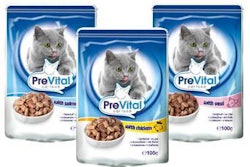It's a business axiom that to succeed, you have to meet customers' needs. But when it comes to feeding pets, is that always true? Should the petfood industry be more cognizant of how current trends like high meat content, no grains, premium and "human grade" ingredients—that, yes, consumers are demanding and buying—affect pets' health and the ingredient supply chain?
In most cases, the results of these trends are positive, but not all are. According to the latest survey from the Association for Pet Obesity Prevention, the US pet obesity rate hit an all-time high in 2012: 52.5% of dogs and 58.3% of cats are now considered overweight or obese by their veterinarians. What's worse, many of their owners don't see or acknowledge their pets' conditions: About 45% of these respondents consider their pets to be normal weight.
Pet obesity is a human behavior problem, not just a nutritional disease, said Katherine Kerr, PhD, post-doctoral research associate in the Department of Animal Science at the University of Illinois, in a Petfood Forum 2013 presentation, After all, pets do not pour their own bowls of food. However, Kerr pointed out how energy dense most petfoods are today, as petfood companies have understandably ridden the premium/superpremium bandwagon to increasing sales and margins (p. XX).
With pets, excess energy intake of just 1% to 2% can lead to overweight or obesity, Kerr said. While most petfood labels say to adjust feeding amounts as necessary for each pet, she added, how can we expect pet owners to make those adjustments when many don't realize or acknowledge their pets are overweight? Even if they do, they most likely don't understand how energy values of the petfood translate to amounts fed.
"Often based on consumer demand rather than nutritional requirements, many commercial petfoods are formulated to provide nutrients in excess of current minimum recommendations, use ingredients that compete directly with the human food system or are overconsumed by pets, resulting in food wastage and obesity," wrote a team of researchers led by Kerr's advisor, Kelly Swanson, PhD, in a recent paper, "Nutritional Sustainability of Pet Foods." It addressed the long-term impact of formulation practices on pet health and sustainability of ingredients used. That use puts our industry in direct competition with the human food industry, which is already struggling to feed a growing global population.
Swanson's research revealed how certain ingredients are more sustainable — thus, in the long run, more available and affordable — than others. That's partially because dogs and cats require specific nutrients, not specific ingredients, making it possible to meet requirements with a variety of sources. "If you just change the diet a little, the financial and environmental costs associated with it are quite different," he explained.
Case in point: By-products have a negative image among many consumers, whose only information has likely come from activists and bloggers who describe things like chicken beaks and feet, rather than secondary products from the human food chain such as organ meats or from ethanol production like DDGS (dried distillers grains with solubles). The fact is, by-products often offer more nutritional benefits because of pets' unique needs and because they are better suited to petfood processing methods, helping assure more of the nutrients remain intact.
Another positive: By-products are highly sustainable. This presents a significant opportunity for petfood companies because consumers often want to support eco-friendly products, practices and companies. "Petfood professionals have the opportunity to address these challenges and influence the sustainability of pet ownership through product design, manufacturing processes, public education and policy change," concluded Swanson and his team.
Google+
















